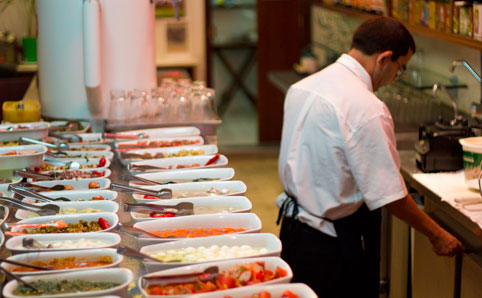
With São Paulo’s rich history of immigration, its botecos are as varied as its DNA, from Portuguese tascas, Italian cantinas and Japanese izakayas to the myriad local joints run by Brazilians from the length and breadth of the country. Read on for a round-up of five botecos, each representing, with varying degrees of authenticity, São Paulo's myriad immigrant cultures.
Amigo Leal | Elídio Bar | Bar do Luiz Nozoie | Rota do Acarajé | Valadares
Amigo Leal
Rua Amaral Gurgel 165, República, 3223 6873, amigoleal.com.br
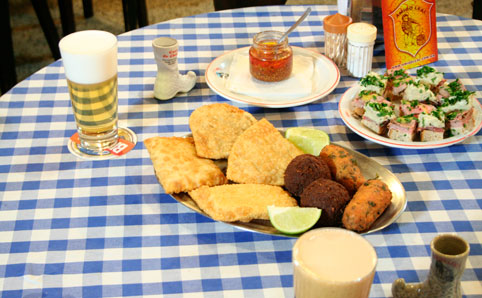 |
- OPENED 1967
- ORIGIN German
- GO FOR Eisbein (pigs’ knees)
It was Leopoldo Urban, a Brazilian of German descent, who first opened Amigo Leal (which translates as ‘loyal friend’), back in 1967 with a business partner. He only stuck around for one year before going on to set up – and lend his name to – the now infamous Bar Léo, but the original German-inspired decor, with high ceilings and wood panels, is the same to this day.
German dishes are the star of the menu, notably the eisbein (pigs’ knees). ‘Each knee weighs nearly a kilo,’ says Leonardo Ramos, 50, the current owner who has been behind the bar since he turned 18. ‘We cook them for four hours,’ he goes on. The result is a tender hunk of pork, served with boiled potatoes and sauerkraut. To drink, Ramos recommends Steinhäger (a German gin flavoured with juniper berries).
‘At night, musicians come from the Teatro Municipal, while at weekends, it’s all about families,’ says Ramos.
Elídio Bar
Rua Isabel Dias 57, Mooca, 2021 3097, elidiobar.com.br
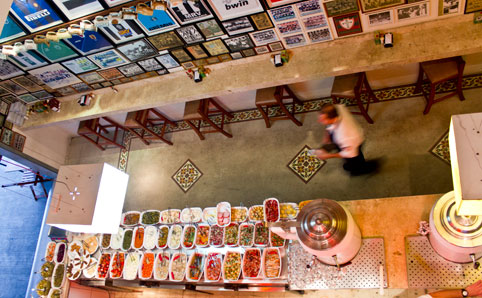 |
- OPENED 1959
- ORIGIN Italian
- GO FOR acepipes (antipasti)
Framed reviews and football memorabilia cover the walls at Elídio Bar, charting the 53 years since the bar opened. ‘My father supports Palmeiras football club, which originally came from Italy,’ says Elídio Raimundi’s daughter Celeste. ‘But we’ve got football shirts here from all the big teams.’
Elídio’s grandfather originally opened a café here, in the traditionally Italian neighbourhood of Mooca, but it later became a bar. Over the years it’s earned quite a reputation for its acepipes – a buffet of up to 100 different types of antipasti laid out on top of the bar.
The Raimundi’s forebears hailed from the northern Italian region of Veneto, and Celeste says their buffet of acepipes is typical of that region. But it’s not exclusively Italian – you’ll find everything from Brazilian cod balls to Spanish chorizo here alongside the likes of Gorgonzola cheese and a Parmesan wheel.
Bar do Luiz Nozoie
Avenida do Cursino 1210, Saúde, 5061 4554, bardoluiznozoie.com.br
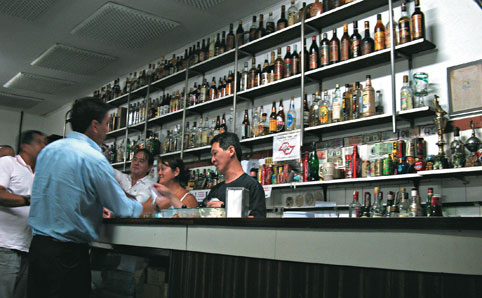 |
- OPENED 1962
- ORIGIN Japanese
- GO FOR Porção de frutos do mar (seafood served cold)
Down in the South of São Paulo, Bar do Luiz Nozoie has been going for decades, and is still very much a family-run operation. ‘We don’t employ waiters,’ says Marcia, daughter of founders Luiz and Shizue. ‘People just come up to the bar to order. It’s a simple place.’
Marcia, aged fifty, is at the helm most evenings. Her father Luiz is less active in the business than he was, but still goes to down to the port in Santos once a month to stock up on the seafood – prawns, squid, octopus and mussels – used in the porção de frutos do mar (seafood served cold with a vinaigrette. ‘We used to do tempura. But the food now is not particularly Japanese,’ Marcia says, laughing. ‘We’re just Japanese in appearances.’
For Marcia, making the perfect bar snack is all about the ingredients, and doing things with pleasure. ‘Whatever you do, if you don’t do it with love, it won’t turn out well.’
Rota do Acarajé
Rua Martim Francisco 529/533, Santa Cecília, 3668 6222, rotadoacaraje.com.br
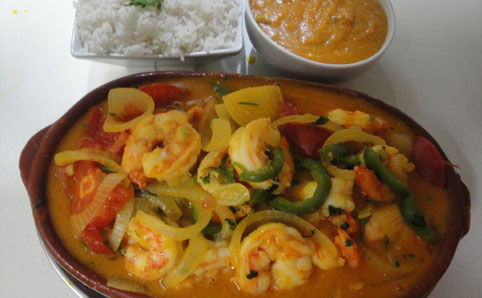 |
- OPENED 2002
- ORIGIN Bahia
- GO FOR acarajé
From its long coast to its vast, dry interior, Brazil’s North East is the homeland of some of the best-known Brazilian dishes, like feijoada (pork and bean stew), and moqueca (fish stew). In São Paulo, media-friendly eateries like Mocotó draw unrivalled queues at the weekend, while lesser-known but no less authentic spots like Mocofava in the north-eastern suburb of Mandaqui keep things more local.
For a taste of the North East without the day trip to the suburbs, Rota do Acarajé is a good bet. Despite flying the Bahian flag, the owners are from São Paulo. Luisa Inês Salida, 56, and husband Ricardo Gil Godoy Fonseca, 54, set up the friendly bar-restaurant in 2002, and have gone about things in a seemingly authentic way: the beans, cachaça and dried shrimps are all sourced from Salvador, and there’s even a staff of Baianas in the kitchen preparing the delicious namesake dish – acarajé (a bean patty fried in palm oil).
‘We also serve another Bahian snack – abará – it’s the brother to acarajé,’ says Salida, describing the similar bean snack, which is steamed and served in a banana leaf.
Valadares
Rua Faustolo 463, Lapa, 3862 6167, barvaladares.com.br
 |
- OPENED 1962
- ORIGIN Minas Gerais
- GO FOR Torresmo (pork scratchings)
Celebrating its fiftieth birthday this year, Valadares is a home from home for many Mineiros (people the neighbouring state of Minas Gerais) in São Paulo, as well as a mecca for those curious to try its unconventional nibbles. Dishes like rã touro à milanesa (frog Milanese) and testículos de boi (Rocky Mountain oysters, or bulls’ balls) are just two of the popular dishes served at this laid-back bar.
‘Torresmo (pork scratchings) is our champion snack,’ says Mauricio Moraes, a nephew of the original band of four brothers who opened the bar back in 1962. ‘The menu has changed a bit over the years, but it’s still very much food from Minas,’ says Moraes. Sample the torresmo in a portion of tradição do Valadares, half super-salty pork scratchings and half potatoes, sprinkled with manioc flour, garlic and chilli.
The drinks menu is as extensive as the snacks. ‘People love our batidas,’ says Moraes, bigging up the sweet cachaça cocktails, whizzed up in a blender. ‘Especially the peanut one.’
On sunny afternoons, grab a table on the pavement and watch the world in this quiet corner of Lapa go by.

